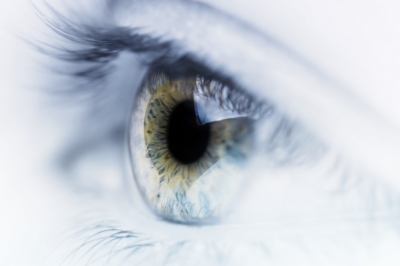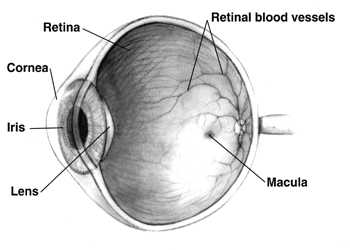 Harvard Stem Cell Institute scientists have a vision to treat the progressive loss of eyesight associated with aging at its source—the retina.
Harvard Stem Cell Institute scientists have a vision to treat the progressive loss of eyesight associated with aging at its source—the retina.
Eighty percent of Americans fear losing their sight. But, unfortunately, after the age of forty, macular degeneration, and with it cloudy, soft, blurred vision at best, becomes a reality for millions of people.
Age-related macular degeneration, and Stargardt disease, the most common form of inherited juvenile macular degeneration, are diseases of the retina that cause a loss of central vision over time. The retina is a layer of light-sensitive cells, called rods and cones, lining the back of the eye. These cells translate light information from the environment to signals that can be processed into sight by the brain. Problems occur when the retina weakens due to age or when blood vessels break around the retina, such as in diabetic retinopathy. Retinal breakdown is also caused by retinitis pigmentosa, a group of related inherited diseases affecting an estimated 100 thousand Americans. These diseases include Usher syndrome, Bardet-Biedl syndrome, and Refsum disease, among others.
Treatment Strategies
The Harvard Stem Cell Institute (HSCI) brings together faculty members at the Massachusetts Eye and Ear Infirmary, Harvard Medical School, and other Harvard-affiliated Hospitals and institutions who work on understanding the mechanisms that cause eye diseases. These collaborations have been actively generating multi-disciplinary regeneration and preservation therapies with potential clinical applications.
Regeneration Therapies
HSCI scientists working on the generation and transplantation of retina stem cells are already seeing success. In one experiment, retina stem cells derived from an adult mouse skin cell were transplanted into another mouse with retina degeneration. The retina stem cells migrated to the correct location in the recipient mouse’s brain, improving its vision. To deliver this kind of treatment, our researchers have found a protein that breaks down the outer surface of a damaged retina and allows healthy donor cells to integrate and wire themselves into recipient tissue.
 Other HSCI investigators are looking at the clinical applications of a natural ability in fish to repair the injured retina. Müller cells in fish have the ability to revert back to a stem cell form and regenerate damaged eye tissue. Humans and mice also have Müller cells, but internal signals prevent the cell type from carrying out regenerative duties. Our researchers are searching for chemical compounds that can overcome such inhibitions, so that human Müller cells can repair damaged retinas.
Other HSCI investigators are looking at the clinical applications of a natural ability in fish to repair the injured retina. Müller cells in fish have the ability to revert back to a stem cell form and regenerate damaged eye tissue. Humans and mice also have Müller cells, but internal signals prevent the cell type from carrying out regenerative duties. Our researchers are searching for chemical compounds that can overcome such inhibitions, so that human Müller cells can repair damaged retinas.
Preservation Therapies
Another approach to eye disease is to maintain the retina’s structure so that transplanted or regenerated cells can thrive and restore vision. HSCI scientists are using gene therapy to generate, in cells, a molecule known to preserve healthy vision. Expression of this molecule should prevent the retina from breaking down. Research also shows that diseased retina cells are often malnourished and prone to stress. Studies into how to remedy these conditions could produce new types of therapies.
Other Eye Diseases
The cornea is a thin, transparent layer of cells on the front of the eye that allows light to pass through to the retina. Changes in the cornea can lead to sight distortion commonly known as astigmatism. HSCI investigators are conducting preclinical studies with corneal stem cells in hopes that transplantation can help repair cornea damage in humans.
